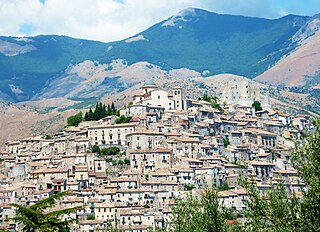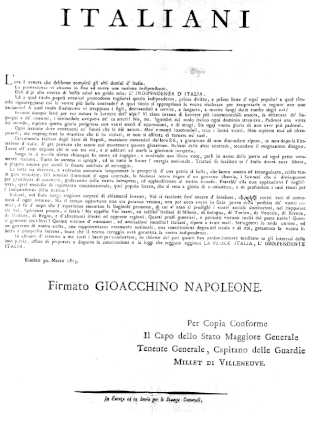
The Hundred Days, also known as the War of the Seventh Coalition, marked the period between Napoleon's return from eleven months of exile on the island of Elba to Paris on 20 March 1815 and the second restoration of King Louis XVIII on 8 July 1815. This period saw the War of the Seventh Coalition, and includes the Waterloo Campaign and the Neapolitan War as well as several other minor campaigns. The phrase les Cent Jours was first used by the prefect of Paris, Gaspard, comte de Chabrol, in his speech welcoming the king back to Paris on 8 July.

The Carbonari was an informal network of secret revolutionary societies active in Italy from about 1800 to 1831. The Italian Carbonari may have further influenced other revolutionary groups in France, Portugal, Spain, Brazil, Uruguay, the Ottoman Empire, and Russia. Although their goals often had a patriotic and liberal basis, they lacked a clear immediate political agenda. They were a focus for those unhappy with the repressive political situation in Italy following 1815, especially in the south of the Italian Peninsula. Members of the Carbonari, and those influenced by them, took part in important events in the process of Italian unification, especially the failed Revolution of 1820, and in the further development of Italian nationalism. The chief purpose was to defeat tyranny and establish a constitutional government. In the north of Italy other groups, such as the Adelfia and the Filadelfia, were associate organizations.

Joachim Murat was a French Army officer and statesman who served during the French Revolutionary and Napoleonic Wars. Under the French Empire he received the military titles of Marshal of the Empire and Admiral of France. He was the first Prince Murat, Grand Duke of Berg from 1806 to 1808, and King of Naples as Joachim-Napoleon from 1808 to 1815.

The War of the Second Coalition was the second war targeting revolutionary France by many European monarchies, led by Britain, Austria, and Russia and including the Ottoman Empire, Portugal, Naples and various German monarchies. Prussia did not join the coalition, while Spain supported France.

The Battle of Maida, fought on 4 July 1806 was a battle between the British expeditionary force and a French force outside the town of Maida in Calabria, Italy during the Napoleonic Wars. John Stuart led 5,236 Anglo-Sicilian troops to victory over about 5,400 Franco-Italian-Polish troops under the command of French general Jean Reynier, inflicting significant losses while incurring relatively few casualties. Maida is located in the toe of Italy, about 30 kilometres (19 mi) west of Catanzaro.

The Neapolitan War, also known as the Austro-Neapolitan War, was a conflict between the Napoleonic Kingdom of Naples and the Austrian Empire. It started on 15 March 1815, when King Joachim Murat declared war on Austria, and ended on 20 May 1815, with the signing of the Treaty of Casalanza. The war occurred during the Hundred Days between Napoleon's return from exile and before he left Paris to be decisively defeated at the Battle of Waterloo. The war was triggered by a pro-Napoleon uprising in Naples and ended with a decisive Austrian victory at the Battle of Tolentino, after which Bourbon monarch Ferdinand IV was reinstated as King of Naples and Sicily. However, the intervention by Austria caused resentment in Italy, which further spurred on the drive towards Italian unification.

Guglielmo Pepe was an Italian general and patriot. He was brother to Florestano Pepe and cousin to Gabriele Pepe. He was married to Mary Ann Coventry, a Scottish woman who was the widow of John Borthwick Gilchrist, linguist and surgeon to the East India Company.

The Battle of Tolentino was fought from 2–3 May 1815 near Tolentino, Kingdom of Naples in what is now Marche, Italy: it was the decisive battle in the Neapolitan War, fought by the Napoleonic King of Naples Joachim Murat to keep the throne after the Congress of Vienna. The battle occurred during the Hundred Days following Napoleon's return from exile and, like the Battle of Waterloo, resulted in a decisive victory for the Seventh Coalition, leading to the restoration of the previous Bourbon king, Ferdinand I.

The Italian campaigns of the French Revolutionary Wars (1792–1801) were a series of conflicts fought principally in Northern Italy between the French Revolutionary Army and a Coalition of Austria, Russia, Piedmont-Sardinia, and a number of other Italian states.
The Battle of Occhiobello was fought on 8 April – 9 April 1815 and was the turning point of the Neapolitan War. Joachim Murat, King of Naples was repulsed by an Austrian force under the command of Johann Frimont whilst trying to cross the bridge over the Po River at Occhiobello. Following the battle, the Austrians would not lose an engagement for the remainder of the war.

The Battle of Cesenatico was a minor battle in the Neapolitan War that took place on 23 April 1815 in the town of Cesenatico on Adriatic coast.

Adam Albert, Count von Neipperg was an Austrian general and statesman. He was the son of a diplomat famous for inventing a letter-copying machine, and the grandson of Count Wilhelm Reinhard von Neipperg. His second wife, Empress Marie-Louise, was the widow of Napoleon and a daughter of Francis II, the last Holy Roman Emperor and founding Emperor of the Austrian Empire.
The Battle of Scapezzano was a short engagement during the Neapolitan War on 1 May 1815 between an Austrian corps under Adam Albert von Neipperg and a Neapolitan division under Michele Carrascosa.
The Treaty of Casalanza, which ended the Neapolitan War, was signed on 20 May 1815 between the Napoleonic Kingdom of Naples on the one hand and the Austrian Empire, as well as the Great Britain, on the other. The signature occurred in a patrician villa, owned by the Lanza family, in what is now the commune of Pastorano, Campania, southern Italy.

The Battle of Campo Tenese saw two divisions of the Imperial French Army of Naples led by Jean Reynier attack the left wing of the Royal Neapolitan Army under Roger de Damas. Though the defenders were protected by field fortifications, a French frontal attack combined with a turning movement rapidly overran the position and routed the Neapolitans with heavy losses. The action occurred at Campotenese, a little mountain village in the municipality of Morano Calabro in the north of Calabria. The battle was fought during the War of the Third Coalition, part of the Napoleonic Wars.

The Battle of Faenza, also known as the Battle of Castel Bolognese on February 3, 1797, saw a 7,000 troops from the Papal Army commanded by Michelangelo Alessandro Colli-Marchi facing 9,000 troops from the French Army under the command of Claude Victor-Perrin. The veteran French troops quickly overran the Papal army, inflicting disproportionate casualties. The town of Castel Bolognese was located on the banks of the Senio River 40 kilometres (25 mi) southeast of Bologna, and the city of Faenza was also nearby. The action took place during the War of the First Coalition, as part of the French Revolutionary Wars.

The Rimini Proclamation was a proclamation by Joachim Murat, King of Naples, calling for the establishment of a united, self-governing Italy ruled by constitutional law. Its text is widely attributed to Pellegrino Rossi, later Papal Minister of Interior under Pope Pius IX. While it is primarily considered as a desperate attempt from Murat to retain the Neapolitan throne, the Rimini Proclamation was among the earliest calls for Italian unification.

The Kingdom of Naples was a French client state in southern Italy that existed from 1806 to 1815. It was founded after the Bourbon Ferdinand IV & III of Naples and Sicily sided with the Third Coalition against Napoleon, and was in return ousted from his kingdom by a French invasion. Joseph Bonaparte, elder brother of Napoleon, was installed in his stead: Joseph conferred the title "Prince of Naples" to be hereditary on his children and grandchildren. When Joseph became king of Spain in 1808, Napoleon appointed his brother-in-law Marshal Joachim Murat to take his place. Murat was later deposed by the Congress of Vienna in 1815 after striking at Austria in the Neapolitan War, in which he was decisively defeated at the Battle of Tolentino.

The Army of the Kingdom of Naples was the land force of the Kingdom of Naples. It was in service from 1806 to 1815, reborn from the Army of the Two Sicilies after the French invasion of Naples. It served alongside Napoleon’s Grande Armée in various campaigns of the Napoleonic Wars, until its final demise in the Neapolitan War.

The Italian campaign of 1813–1814 was the series of military operations of the War of the Sixth Coalition, mainly in Northern Italy, that pitted the French Empire and the Kingdom of Italy against Coalition forces led by Austria and Britain. It represented the last stage of the so-called "French period", beginning with the Italian campaign of 1796–1797, in which a French and an Austrian army confronted each other for control of the Italian peninsula. The Austro-Neapolitan War of 1815 was essentially a clash between only Italians and Austrians.


















